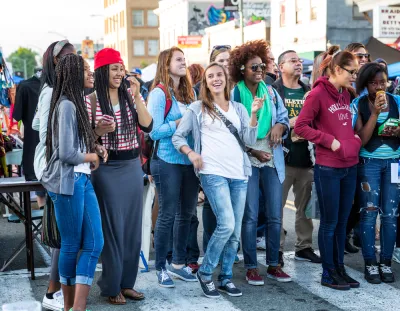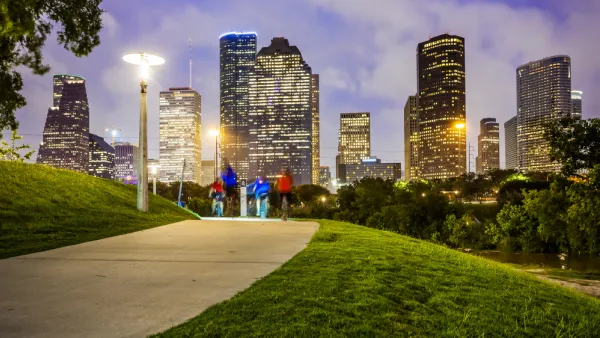A study recently published in the Journal of the American Planning Association finds that the APA's definition of "great neighborhoods" might be leaving low-income and minority populations behind.

Adapted from: Talen, Emily, Sunny Menozzi, and Chloe Schaefer. "What Is a 'Great Neighborhood'? An Analysis of APA's Top-Rated Places." Journal of the American Planning Association 81, no. 2 (April 3, 2015): 121–41. doi:10.1080/01944363.2015.1067573.
The American Planning Association's (APA) annual "Great Neighborhoods" program was established to define the "gold standard" of neighborhoods in America. The profession and the public perceive the designation as an authoritative and normative judgment about what a Great Neighborhood in America is supposed to be.
We wanted to know whether qualitatively better places are likely to lack affordability, and therefore diversity, is evident in the APA's Great Neighborhoods competition. Using Census and other data covering the 80 APA-designated Great Neighborhoods to date (2007–2014), we found that, unfortunately, yes—APA's Great Neighborhoods represent a somewhat classic conception of the historic, gentrifying urban neighborhood: walkable, gridded, and losing social diversity.
One finding was that there is a huge disparity in median housing price—a $108k difference—between "Great Neighborhoods" and the tracts that immediately surround them. We also looked at trends over time. In 1970, APA's Great Neighborhoods had a lower percentage of white residents and a higher percentage of black residents compared to other cities. But this racial profile reversed by 2010, when APA Great Neighborhoods had a higher percentage of white residents and lower percentages of black and Hispanic residents when compared with cities as a whole.
According to our analysis of the data, APA Great Neighborhoods have not bucked the trend that desirable physical qualities lead correspondingly to lack of affordability and social diversity.
What should APA do about that?
Historic, walkable neighborhoods in America are a treasure. But there is a downside: they are also often losing their diversity and affordability, often in places (centrally located, near transit) where diversity and affordability are most needed.
Of course, not all historic, walkable neighborhoods lack diversity—many neighborhoods do "have it all." Our point is that these are the neighborhoods that need to be recognized more fully and supported as the true "gold standard" of a Great Neighborhood in America.
Unfortunately, the APA seems to be agnostic on the issue of increasing income segregation. The maintenance of affordability and social diversity is not even an explicit criterion of what a "Great Neighborhood" is supposed to be. This defies a long-standing ethical principle in American city planning: that neighborhoods should be both well-designed and socially inclusive.
We wonder why APA isn't more concerned about the perception of insensitivity with respect to America's income and racial inequality drama—with its fundamental linkage to housing—now playing out across the land.
We wonder why APA is not more sensitive to the connection between a strong sense of neighborhood identity and the potential for social exclusion in their Great Neighborhoods designation. The APA should limit their gold standard to neighborhoods that score well on the APA's criteria but that also manage to retain affordability and social diversity.
Specifically, might APA consider adding the following as a criterion of a "Great Neighborhood":
- Where gentrification pressure is evident or likely, a "Great Neighborhood" shows a demonstrated commitment to the maintenance of affordability and social diversity.
We need APA to take a principled stand instead of further debating the merits of this issue. Why not specifically include affordability and the maintenance of social, racial, or ethnic diversity as a necessary criterion of a "Great Neighborhood"?
Emily Talen ([email protected]) is professor at the School of Geographical Sciences and Urban Planning at Arizona State University. Sunny Menozzi ([email protected]) and Chloe Schaefer ([email protected]) are recent graduates of the Department of Urban Studies and Planning at the Massachusetts Institute of Technology.

Analysis: Cybertruck Fatality Rate Far Exceeds That of Ford Pinto
The Tesla Cybertruck was recalled seven times last year.

National Parks Layoffs Will Cause Communities to Lose Billions
Thousands of essential park workers were laid off this week, just before the busy spring break season.

Retro-silient?: America’s First “Eco-burb,” The Woodlands Turns 50
A master-planned community north of Houston offers lessons on green infrastructure and resilient design, but falls short of its founder’s lofty affordability and walkability goals.

Test News Post 1
This is a summary

Analysis: Cybertruck Fatality Rate Far Exceeds That of Ford Pinto
The Tesla Cybertruck was recalled seven times last year.

Test News Headline 46
Test for the image on the front page.
Urban Design for Planners 1: Software Tools
This six-course series explores essential urban design concepts using open source software and equips planners with the tools they need to participate fully in the urban design process.
Planning for Universal Design
Learn the tools for implementing Universal Design in planning regulations.
EMC Planning Group, Inc.
Planetizen
Planetizen
Mpact (formerly Rail~Volution)
Great Falls Development Authority, Inc.
HUDs Office of Policy Development and Research
NYU Wagner Graduate School of Public Service




























